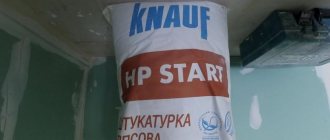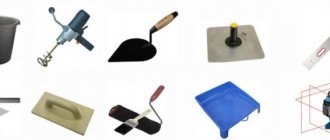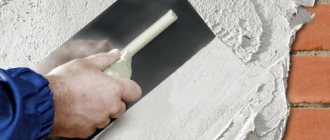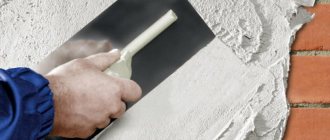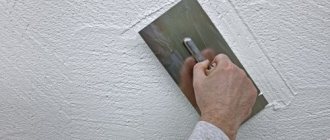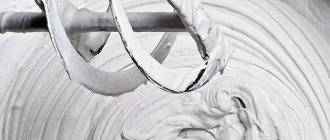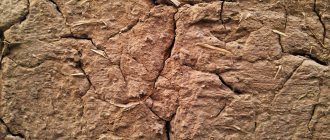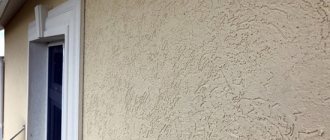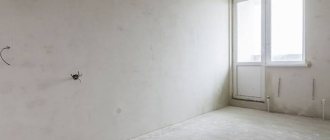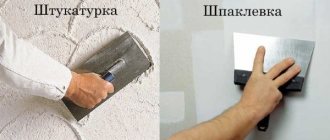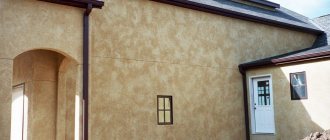Why does Rotband plaster harden immediately after mixing?
The store advised me to buy the famous Rotband plaster, but it immediately hardens after mixing.
Why is this happening? Plaster, or rather plaster prepared from a ready-made gypsum mixture (as people say, just add water) and it doesn’t matter whether it’s “Rotband” or some other brand of plaster can immediately harden after mixing! - in only one case this is:
Expired/Expired expiration date/freshness of the mixture - and nothing more, you can’t add here, they just slipped you an expired product, or you already had it lying around for quite some time before you started using it!
I can suggest two reasons for the rapid hardening of Rotband gypsum plaster, from my own experience.
1 reason - small amount of water. It seems that there is enough water, but the plaster absorbs it so quickly that it begins to harden before our eyes, even before it has been completely used.
This happens for the reason that it is not always possible to mix different batches with the same proportions, you always look at it by eye, sometimes you add more than in the instructions, and sometimes less.
This can happen either due to non-compliance with the technology during production (they also added more of something and less of something), or because the plaster has been lying around in warehouses for a long time and has already caked, i.e. lost its initial characteristics.
Reason 2 - before using plaster, always pay attention to the date of manufacture and expiration date, since it is possible that if the plaster is old, it no longer has the properties that are included in the specifications.
What happens is that the gypsum plaster itself is a mixture of natural gypsum material, well crushed and roasted in ovens, with certain additives that regulate the rate of hardening, and also contains anti-caking additives and many others.
When the plaster sits for a long time, the mixture can separate or become compacted and before use it must be sifted so that it at least takes in air (it’s like flour before kneading dough).
If the impurities are compacted, then the water will combine only that mass that is in a crumbly state (visually this may not be noticeable).
So it turns out that the ingredient that is responsible for the rate of hardening does not work.
How to work with such plaster
Rotband's kneading technology is as follows:
- For 30 kilograms of dry mixture you need only 18 liters of water. We make the batch in a plastic barrel.
- First you need to pour a small amount of plaster into the water and stir it by hand. Then gradually add the rest and stir with a construction mixer at low speed.
- In order for the polymers in its composition to work, let our barrel stand for 5 minutes and mix again.
- Be sure to mix with a mixer. Remember, there should be no lumps!
- The lifespan of the finished solution is about half an hour. Therefore, the above technology is intended for the construction team. Since you will be working with your own hands, you will have to empirically select the required amount of the finished composition in order to produce it completely and not throw away the dried one.
On a note. Both dry mixture and water can be added to the finished solution. An important condition is to stir and let stand for 5 minutes, then stir again. When leveling walls using beacons for the first time, it is impossible to accurately calculate the volume of solution produced in 30 minutes. Therefore, this property of Rotband plaster can be considered a godsend for beginners in the construction business.
Top 5 ways to prevent plaster from drying quickly
Gypsum, used in construction and finishing works, is also called alabaster. In total, there are 3 main types of gypsum grinding, which affect its hardening time. The finest grind of gypsum in the solution will harden in just 2 minutes, and the coarsest grind in 20. But even this time is not enough to complete a large amount of work. Therefore, they use some tricks - add ordinary components to the solution that can be found in any home:
- PVA glue. This component can be added in a ratio of 1 to 4, relative to water in solution.
- High fat milk. You cannot use milk whose fat content is below 3.2%. To dilute the mixture, you need to add a volume of milk that is 10-20% of the volume of water. If you increase the amount of milk, you can further increase the hardening time of the solution.
- Wallpaper glue. In this case, the glue will be the basis for the solution, instead of water. By dissolving alabaster in wallpaper glue, the hardening time can be “stretched” by another 20 minutes.
- Table vinegar. Thanks to vinegar, the hardening of the mixture can be increased by 50 minutes. It is enough to add vinegar to the solution in a ratio of 2 tbsp. spoons per half liter of water.
- Laundry or liquid soap. This additive will also increase the “lifetime” of the solution by only 20-30 minutes, but it is accessible and on hand. Laundry soap is dissolved at the rate of 100g per 1 liter of water, and liquid soap should be 20% of the volume of water.
why does gypsum plaster harden quickly?
Why does rotband harden quickly?
In the Construction and Repair section, the question Plaster hardens quickly. asked by the author Maxim Mikhailov the best answer is add vinegar.
Answer from 2 replies[guru]
Hello! Here is a selection of topics with answers to your question: Plaster hardens quickly.
Answer from Viking[newbie]Both rodband and volma quickly harden if1. The bag was opened and lay next to a bucket of water for a week and it became saturated with moisture. Only a new bag will save you.2. Plastering has expired. Dilute a little 2-3 kg3. They overfilled the water and didn't add enough water. NEW4. Stir once and do not repeat the kneading after 3-4 minutes. And the crystallization process was activated.5. You didn’t wash the tool (whisk) and the bucket of curdled solution activated a new one.
Answer from Inna cofina[newbie]I exposed the lighthouses with wave plaster. The next day everything fell off. The wave was stored in a warm house for 6 months. Why doesn't plaster work?
Answer from Alexey Alekseev [guru] The mixing container needs to be washed every time. And the teplon begins to set, it seems, even longer than the rotband
Answer from Kamil Magadov [newbie] In Dagestan, one large office was busted. Which supplied the entire republic with a large number of rottbands, etc. The quality was a little better than human shit
Answer from Art - a godsend [guru] At a time when the choice was not great with mixtures, I added wallpaper glue to alabaster or plaster. the rate of hardening increased. You probably got a manufacturing defect, or you are spreading the masses too much. On each label there is a pot life of the solution.
Answer from Andrey Volkov[guru]Kneading a Rotbant bag should be completed in 30 minutes. You can work with Volma for 1 hour - it’s the best mixture for ceilings (but you need to get used to it after the same Rotbant. How long does it take for the solution to set? To be honest, I didn’t work with heat - but the tool - and especially the basin - must be washed before mixing and stirring the mixture with cold with water This is Rotbant: This is Volma: If the mortar on my walls set quickly, I would even be glad. Now I’ll definitely try Teplon in work. After ceilings, plastering walls is easy and 2 times faster. It is necessary to plaster with cement-sand mortar a couple of times a year - so that life “honey” didn’t seem like it – all these questions will immediately disappear))
Answer from Sergey Nazarov[guru] add water and then the powder, if it’s too thick, it’s better to go to the landfill right away, and you can add it if necessary
Gypsum set retarders - from milk to plasticizer - Blog Stroyremontiruy
Gypsum is used in many construction works, where it acts as an additive to accelerate the hardening of various mixtures and solutions. Sometimes alabaster is used in its pure form, helping to quickly secure a wire in a groove, secure a socket, or perform other work.
The main advantage of the material is the speed of setting, but often this advantage becomes a disadvantage and it is necessary to slow down the setting of the gypsum. For this, organic or inorganic retardants are used, which are bought at a hardware store or found in the kitchen.
When to slow down the setting
Slowing down the setting of alabaster is important when a large amount of work is being performed and there is no desire to dilute the plaster a hundred times in small portions. For example, you need to seal the grooves throughout the room, but Rotband (a gypsum mixture with polymer additives) is not at hand. You can dilute 100 grams of alabaster, but this volume will be enough for 5 minutes of work. If you use a retarder, then dilute 1-2 kg of material at once and perform a multiple greater amount of work in one approach.
So, the main task of slowing down the setting is to increase the volume of mixing the gypsum mixture and to complete a larger piece of work from one batch .
General rules
Before using retarders, we recommend that you follow the general rules for mixing alabaster, otherwise no additives will help. Here are tips that will come in handy when working with plaster:
- Knead only in clean plastic containers,
- Use a clean mixing tool
- First, water is poured into the container, then alabaster is poured.
If there are remnants of old mortar on the tool or in the mixing container, the plaster will set 2-3 times faster. If you first pour gypsum into the container and then pour water, the hardening will also go faster.
Use of retarders
Set retarders are additives that increase the hardening time of alabaster . They are divided into organic and inorganic. Here is a complete list of moderators, the use of which has been confirmed in practice:
- PVA,
- Wallpaper glue,
- Dishwashing liquid (Ferry),
- Liquid soap,
- Boric and citric acid,
- Washing powder,
- Putty Vetonit,
- Milk 3.2 fat content,
- Concrete plasticizer.
In some cases, additional sand is added to the gypsum; this increases the hardening time of the mixture and makes it more durable.
There is no point in describing the proportions of each moderator; we will talk about the use of some of the additives.
There is always milk on hand during repairs. This useful product is used with a bang for diluting gypsum mixtures, but the milk must have a fat content of 3.2%. Milk is added in a proportion of 10% of the amount of water, you can add more, but then the hardening time of the alabaster will also increase.
If Vetonit putty is used for finishing, then it is added to the alabaster in the proportion - 4 parts gypsum - 1 part Vetonit.
One bag of boric or citric acid is enough for 5-10 kg of dry gypsum; first, the acid is diluted with dry alabaster, then the mixture is poured into water and kneaded.
PVA glue is used in the proportion of 1 part glue to 3-4 parts water, and washing powder is added 100 grams per 5 kg of dry alabaster.
Effectively used to slow down the setting of plasticizer for concrete. A plasticizer is added at the beginning of mixing alabaster; the proportions used are the same as for concrete; they are written by the manufacturer on the packaging.
How to increase the viability of gypsum plaster?
9 months ago
Any product is a full-fledged product. It should also be accompanied by instructions for use, which it is advisable to follow. What I mean is that if there are any recommendations written on the packaging, then it is better to adhere to them, since they were written for a reason. However, many masters and “masters” have their own point of view on this matter. Accordingly, there are many ways to increase the pot life of a mixture.
Construction mixtures are cooking. When you mix them, you prepare a dish. Therefore, never experiment on site, first try the recipe at home, experiment and only then serve it to the masses.
LiveInternetLiveInternet
—Categories
- ***IN THE WORLD OF ANIMALS (411)
- bugs (5)
- animals (59)
- Koteikino (169)
- birds (25)
- fish (8)
- puppy (16)
- lizards, frogs (2)
- ***VEDA (882)
- aromatherapy (2)
- fortune tellers (42)
- mushrooms (64)
- stone kingdom (25)
- World (81)
- Magic (228)
- Charms and prayers (22)
- oxymomon (208)
- runes and staves (11)
- herbalist (149)
- traditions (39)
- ***SURVIVALS (10)
- ***KIDS (110)
- ***FOR THE SOUL (134)
- ***FOR DIARY (1103)
- clipart (103)
- next buttons (103)
- comments (43)
- tutorials (184)
- congratulations (23)
- dividers (25)
- frames (271)
- themes and schemes (192)
- flash animations (44)
- backgrounds (74)
- photoshop (17)
- epigraphs (23)
- ***FOR COMPUTER (96)
- Internet adventure games (12)
- wallpaper (10)
- programs (11)
- tips (26)
- ***HOME SWEET HOME (287)
- whether in the garden, in the vegetable garden (50)
- decor (37)
- and inside (20)
- repair (13)
- from outside (23)
- flowers at home (79)
- flowers on the street (65)
- ***WONDERFUL PEOPLE (244)
- famous personalities (24)
- stories (25)
- remember - mourn (25)
- ***FINE ART (1947)
- illustrations (265)
- pin up (19)
- sculpture, figurines (91)
- sur (29)
- fantasy (56)
- Artists (1486)
- ***HISTORY (242)
- Great Patriotic War (76)
- USSR (38)
- Stalin (21)
- ***MOVIE, MOVIE, MOVIE. (6)
- drama world (56)
- cartoons (18)
- servants of Melpomene (124)
- movie, movie, movie. (37)
- ***BOOKSHELF (709)
- Yevtushenko (25)
- Irina Samarina- Labyrinth (33)
- bookshelf (31)
- radio play (14)
- Rozhdestvensky (18)
- poems (462)
- Eduard Asadov (6)
- Yuri Vizbor (2)
- ***BEAUTY AND HEALTH (517)
- hair (84)
- home pharmacy (239)
- home cosmetics (74)
- beauty terrible power (27)
- manicure (21)
- rejuvenating (45)
- legs (5)
- weight loss (17)
- ***FASHION NEWS (258)
- atelier (162)
- Boho (32)
- stars and mods (2)
- national costume (1)
- shoe (4)
- finishing (15)
- retro (21)
- ***MUSIC (70)
- clips (24)
- let's dance (4)
- let's sing (25)
- ***A LITTLE ABOUT POLITICS (448)
- anti-corruption (58)
- Barmaleyka (2)
- Have an opinion (126)
- reserve (14)
- history (160)
- Konstantin Semin (7)
- Superpower News (5)
- ***POSTRYAPUSHKI (2029)
- without fish and meat (24)
- tasty treats (331)
- twists (157)
- snacks (383)
- gas stations (77)
- m-i-i-yaso (197)
- flour (190)
- drinks (178)
- national cuisine (62)
- R-y-i-bka (42)
- salads (134)
- soup (31)
- cakes (223)
- ***HOLIDAY MOOD (242)
- March 8 (8)
- valentines (11)
- palm (2)
- Maslenitsa (4)
- new year (107)
- Easter (22)
- congratulations (17)
- retro cards (62)
- ***REFLECTIONS ON LIFE (445)
- memories (14)
- funny (82)
- beauty is in simplicity (110)
- Mr Freeman (45)
- wisdom of the people (31)
- way to yourself (110)
- quote book (28)
- ***Handcrafts (1203)
- beads (81)
- embroidery needles (79)
- decoupage (14)
- bunnies (12)
- animals (20)
- quilling (8)
- beauty (220)
- baby dolls (44)
- modeling (19)
- folk crafts (21)
- with your own hands (426)
- creations (192)
- flowers (7)
- jewelry (59)
- ***COUNTRY OF THE SOVIETS (166)
- ***PHOTOS (793)
- interesting (64)
- kaleidoscope (62)
- micro and macro (5)
- worldview (194)
- I like (21)
- still lifes (214)
- photographers (106)
- fractals (11)
- flower garden (103)
- ***JOKE OF HUMOR (192)
- demotivators (16)
- Jewish thoughts (3)
- zestiness (5)
- Odessa residents joke (14)
- purely feminine (23)
—Quote book
2 audiobooks for children.. Wojciechowski S. “Mr. Toomey's Christmas Miracle” “Christmas Miracle.
Scheme “Snowflakes. texture" from Mariella_32
My little “Next” transition buttons. Part 3. My little “Next” transition buttons. Part 3.
My little “Next” transition buttons. Part 4 My little “Next” transition buttons. .
My little “Next” transition buttons. Part 5. My little “Next” transition buttons. Part 5. .
Factors influencing the drying period of plaster
Drying a plastered wall depends on several points:
- type of solution;
- temperature and weather conditions;
- the material on which the mixture will be applied;
- thickness of the mixture layer.
To create ideal conditions for the finishing coating, you must strictly follow the rules for applying and using the plaster mixture. When applying a decorative finish to a wet solution, there is a risk of not only ruining the top layer, but also the starting ball. To find out the exact drying time of the surface, you must first find out how long it takes for plaster to dry on walls in rooms with different bases.
Technology of working with gypsum plaster
The beacon alignment technology comes down to the following. Step 1. Mark the wall using a level. Step 2 . We draw vertical lines at a distance of 0.8 meters. Step 3. Draw blots from the rotband along the lines. Step 4 . Now we install beacons on them. Their height is the thickness of our solution. Step 5 . We straighten them exactly to the level. Step 6 . We begin to throw the prepared solution onto the wall or apply it with a trowel. In this way, we process the distance between the beacons to a height of about a meter. Then we take the rule (in our case its length is approximately 1 meter 20 centimeters) and stretch out the plaster. Step 7 . We remove the excess mixture with a spatula and apply it either to the scratches or higher on the wall. For work at heights higher than your height, we use a small stepladder. Step 8 . Having aligned our wall in this way, we move to the next lighthouse. We work in the same way.
On a note. The plasticity of leveling with Rotband plays a cruel joke on us - the mixture can float after you start working with the next section of the wall. Don’t be alarmed, just re-smooth the surface using the rule, removing excess floated mortar.
Brief video instructions for gypsum plaster Knauf Rotband: The process is completed if the finishing coating is tiles or decorative plaster. Leveling with Rotband will require additional steps if we paint or glue wallpaper.
After the plaster layer has set (after about an hour), it must be rubbed down. This is necessary in order to make the surface perfectly smooth. For grouting we use a more liquid solution. We will apply it with a stainless trowel with pressure, tearing off small tubercles.
If necessary, after one layer of grout has dried, you can repeat it.
Types of base
Craftsmen do not have a clear opinion about the drying period of plaster on different surfaces. Following generally accepted recommendations and observations, a 1 mm layer of solution hardens in one day. If the requirements for processing and applying the mixture are met, this period can be significantly reduced. Thus, a plastered wooden surface at an air temperature of up to 25 C and moderate humidity will dry in about 12 hours. The mortar layer for this example is 20 mm. How long does it take for plaster to dry on plasterboard walls? The dry and smooth surface of this material is an ideal base for plastering. The mixture, 2 mm thick, hardens after 8 hours.
The base is made of aerated concrete - a capricious material. With different humidity levels in the room, the drying time of the plaster lasts from 5 to 35 days.
Announcements on NN.RU - Business
Equipment machine for dry cleaning of potatoes and vegetables MSO-16 – designed for cleaning vegetables from soil and black soil.
Welded PM body assembly (PM disker hub) from the manufacturer, the cutting unit of the modernized disk harrow is used on. Price: 2,500 rub.
Suitable for Kitagawa, Samchully, AutoGrip, AutoStrong, Seoam, Tonfou, Chandox, Howa chuck Height 36 mm Similar to HC-06, KSJ6 jaws. Price: 1,625 rub.
Umbrella materials: stainless steel of various thicknesses, galvanized or other similar metals. For example: Ots 1000x700, height 400. Price: 2,000 rubles.
Black, stinking geysers that appeared on the Volga last weekend near Balakhna alarmed Nizhny Novgorod residents. Everyone understands that ours.
Repair is a real challenge for a family. A hundred questions arise that have no answers, and a lot of problems that are urgently needed.
September decided to pamper Nizhny Novgorod residents with warm weather, and Instagram accounts were full of truly autumn shots. Every shot.
Monday morning began with a major accident in the Prioksky district - on Larina Street, a heavy truck loaded with either coal or hot coal.
Types of plaster compositions
The second factor that affects the drying speed of the mixture is its type. The most popular solutions:
- Lime. It is in demand due to its low cost and ease of operation. Has high plasticity. The next layer of the mixture can be applied 6-7 hours after applying the solution. Lime plaster is a reliable type that has been proven over generations.
- Plaster. This type of mixture has gained popularity due to its thermal insulation properties and availability. How long does it take to dry gypsum plaster on indoor walls? From 30 minutes to 3 hours is the minimum period between applying layers. 5 days after applying the finishing ball, complete hardening occurs.
- Cement. This type of solution is easy to use and, moreover, versatile. Cement mixtures are suitable for use in rooms with high humidity, such as the bathroom or kitchen. How long should indoor walls dry after using cement plaster? Depending on the thickness of the layer, this mixture hardens within 2-4 days.
- Clay-cement. A solution with this composition is used in plastering stoves. It is resistant to high temperatures and does not lose its shape. The hardening time for clay-cement mortars is the same as for cement plaster.
Dependence of the drying time of the plaster on the thickness of the applied layer. Of course, the drying speed of the solution cannot but depend on the thickness of the layer. The denser the ball of mixture, the longer it will take to dry. Craftsmen do not recommend applying a layer thicker than 5 cm. A ball with a thickness of 15 to 50 mm is considered the reference.
How to speed up the drying process of plaster
You can plaster walls indoors at temperatures from 10 to 25-27℃. If the temperature is lower or higher, the coating may crack or fail to harden and delaminate. High or low humidity can also interfere with plastering. How long does it take for Rotband gypsum plaster to dry on walls at a humidity above 70%? Almost twice as long as usual, and the use of gypsum solutions in rooms with changes in humidity is undesirable.
Gypsum plaster, its use and consumption
The main substance of the mixture is gypsum - a medium-strength material, hygroscopic, lightweight, and environmentally friendly.
Gypsum plaster is a universal finish that can be used to cover almost any base:
- Dense mineral materials : stone and brickwork, reinforced concrete, expanded clay concrete.
- Loose cellular: Foam concrete.
- Silicate bases: sand-lime brick, aerated concrete.
- Synthetic insulation: polystyrene foam, polystyrene foam.
Gypsum plaster is also universal because it can be used where a solution with thin components is required. For example, in order not to finish with putty, the walls are simply plastered with gypsum mixtures. They contain components with minimal fraction sizes. The solution can replace putty.
Universal gypsum plaster is used for working on any surface, it sets and dries quickly. But its versatility does not depend on its use in aggressive atmospheres - since it is not waterproof!
This finish is not applicable everywhere; the technical capabilities of the material are wide, but not limitless.
Technical characteristics and composition of gypsum plasters
Various components are added to the mixture, depending on its purpose. These are mainly additives that improve specific target characteristics of the solution:
- Bleaching: additives that increase the level of whiteness. Metal salts (titanium white, zinc white) and lime are used. The advantages of ordinary gray gypsum plaster are the absence of additional components, lime and other substances.
- Strength. The composition of gypsum plaster is supplemented with substances that increase its strength characteristics.
- Technological period - the time from mixing the solution to the start of the setting process. Regulated with proprietary additives. Varies from 20 minutes to 2 hours.
- Curing speed.
The composition of gypsum plaster is indicated on the packaging. However, some branded supplements are kept secret.
What does consumption depend on?
The consumption of gypsum plaster per 1 m2 is influenced by only two factors - the thickness of the layer and the evenness of the walls. Other indicators do not matter.
The consumption of gypsum plaster per 1 m2 in normal condition of the working surface (differences in the plane of no more than 5 mm) is approx. 250-300g. Typically, such data is indicated by the manufacturer on the packaging. So, for example, Habez Start MN has the following parameters:
If there are significant distortions of the walls, the following formula must be applied: the sum of the deviation measurement points is divided by the number of these points.
For example, for a wall section of 1 m. square, having a slope of 3 cm, it is necessary to “plumb” (measure the magnitude of the slope with a plumb line) in several places. For example, in three. We get the result: 0, 1.5 and 3 cm. The obtained values are summed up (4.5 cm) and divided by the number of measurements (3). As a result, the consumption of our gypsum plaster per 1 m2 will be 1.5 cm. In this way, you can calculate the volume of plaster solution for a wall that has deformations of any configuration.
The more measurements you record, the more accurate the result. The consumption of gypsum putty and plaster per 1 m2 should be calculated in advance in order to avoid overpaying for material that will remain unclaimed.
How to plaster walls with gypsum plaster
Beginner plasterers who do not know how to properly level and plaster walls with gypsum plaster make mistakes. This is due to a lack of knowledge. Meanwhile, this work is quite simple and consists of several stages.
Preparing the base
The wall must be level. The main deformations and contamination that require attention are:
- Slopes. The use of gypsum plaster makes leveling the walls convenient: the permissible layer thickness is 50mm (in contrast to the thickness of cement-sand finishing with its maximum of 15-20mm).
- Notches. It is better to seal deep depressions and potholes in advance, before applying the base layer.
- Bulges. If possible, it is better to squeeze them. Otherwise, you will have to “increase” the thickness of the layer along the entire wall.
- Remains of finishing are completely removed (pieces of wallpaper, glue, whitewash).
- Mold is a sign of freezing walls and poor ventilation.
You should not hope that internal plastering will solve the mold problem at its root. In addition, this plaster is “weak” for damp rooms.
For smooth walls, surface preparation comes down to cleaning and removing dust, increasing adhesion. Primers are used for this.
Installation of beacons
Do-it-yourself gypsum plaster is greatly simplified if you use beacons - wooden slats or pieces of metal profile, strengthened in the plane of the future plaster.
Beacons are strengthened strictly vertically over the entire surface of the wall with a span width convenient for working as a rule.
Application
The mixed composition is applied to the wall using two spatulas - I scoop up the solution with a small one and transfer it to the work surface of a large one in the way that is most convenient for work.
In large areas, the mass is thrown directly from the trowel or spatula with swinging movements directed away from you.
Alignment
DIY gypsum plaster.
The plaster mixture is leveled using a long (1.5-2m) aluminum lath. The movement is directed from bottom to top so that the rule slides along the beacons, as if along guides. This is how the excess mortar is cut off, removed from the rule with a spatula and thrown onto the wall again (in places where recesses are formed due to a lack of mortar).
Do-it-yourself gypsum plaster is not applied in one go; in some places, after cleaning off the excess, recesses usually form. They need to be filled with plaster mixture and re-worked with the rule.
The movements are zigzag. This allows you to slightly lighten the force applied to the tool.
Do-it-yourself plastering of walls with gypsum (or any other) plaster done in this way is no different from professional work.
When the layer dries, the gypsum plaster is polished - grouted with careful leveling of the surface. The wall becomes so smooth that it resembles glossy paper.
The work consists of thoroughly rubbing the rough edges with a moistened grater. First felt or felt, and then steel.
Glossing with a float is only possible on a well-leveled wall. On uneven surfaces, the tool will leave marks by cutting off bumps. However, this way you can get a more ideal plaster.
Advantages and disadvantages
Gypsum plaster has its pros and cons. It is more convenient to evaluate them by comparing the characteristics of gypsum and cement-sand mixtures:
- Areas of application. Conditions of normal humidity. Cement - in any.
- Durability. Cement-sand ones are more durable.
- Viability of the solution. The time for implementation is several times less than when working with cement mixtures.
- Ease of application. The plaster mass is elastic, easy to apply and level.
- Thermal conductivity - 0.23 W/m×°C, for cement - 0.6÷0.9 W/m×°C.
Plaster is “warmer”. However, due to the insignificant thickness of the layer, this advantage is not fundamental. But physically and tactilely, plaster is more comfortable: if you lean against a wall with a cement-sand finish, it feels colder.
- Drying speed is faster.
- Layer thickness. For cement plasters, it is unacceptable to apply a layer thicker than 1.5-2 cm; when working with gypsum compositions, a thickening of up to 5 cm is allowed.
- Vapor permeability. The figures are relatively close.
- Finishing. Gypsum coatings do not require puttying and can be polished to a shine.
- Price. Gypsum mixtures are more expensive than solutions made from cement and sand.
There is no such thing as a bad material; it is important to use mixtures correctly, for their intended purpose, taking advantage of their benefits correctly. To decide whether to choose gypsum or cement plaster, it is necessary to evaluate the details of a specific wall and a specific situation.
The main disadvantages are poor moisture resistance and insufficient strength - the finish is easy to damage, chip, or scratch. It is not suitable for wall cladding in damp rooms.
The main advantages are ease of use, quick drying and almost complete absence of shrinkage.
Comparative characteristics of plasters from different manufacturers
The characteristics of plasters produced by different companies differ in fillers, their particle size, color, consumption and permissible layer thickness.
Gipswell is a series of plaster mixtures produced by the Russian company Osnovit. The line is represented by four brands:
- Gypswell PG25. Gray mass for manual application. Viability – 1.5 hours, layer thickness up to 8cm! Consumption – 9 kg per sq.m.
- Gypswell PG25 W. White. It differs from PG25 only in color.
- Gypswell PG26 M. Mixture for manual and machine application. Viable for 2 hours, thickness no more than 3 cm. Gray.
- Gypswell PG26 MW. White. Other characteristics are similar to the PG26 M mixture.
All brands are only for finishing rooms with normal humidity. Recommended for plastering bases made of gozo- and foam concrete, concrete walls, brick and stone masonry, fiberglass board, gypsum board, gypsum fiber board.
Giphas is a domestic manufacturer. Produces 3 brands:
- GIFAS START . Mixture for rooms with normal humidity. Consumption at thickness. layer 10mm - 9-11 kg. Color – from gray to white. Viability – 45 min.
- GIFAS MN. For manual and machine application. Consumption 8-10kg. Viable for 40 minutes.
- GIFAS PREMIUM . Pot life 45 min. Color gray, white. Consumption 8.5-10 kg per 1 sq.m.
All mixtures are for interior use, but can also be used in damp rooms provided that special primers are used.
The standard is the mass of production. Available in two types:
- ClimLife standard . Light gray mixture. The thickness of the layer when applied is up to 50mm. Viability – 1 hour (at air humidity 60%). Consumption per sq. m. with a thickness of 1cm – 9kg.
- Reference ClimLife MN . Saves tech. characteristics of the ClimLife line, but requires machine application.
For interior work only.
Bergauf – plaster mixture. There are 3 types of plaster available (all for manual application):
- EASY BAND . A mixture of gray color of varying saturation (due not to the composition, but to the characteristics of the gypsum raw material). The maximum thickness of plaster is 40mm, consumption is 9-12kg per sq.m. Viability – 1 hour.
Feature: the composition includes perlite, which increases the heat-insulating properties of the plaster. Not recommended for painting without additional paint. finishing.
- PRIMA PUTZ GIPS . White color. It differs from EASY BAND in its larger filler fraction.
Recommended for wallpapering of any thickness and painting.
- BAU PUTZ GIPS . Maximum layer thickness – 40 mm, consumption – 11-13 kg per sq. m.
Recommended for application under decorative plasters.
All compositions are intended for plastering rooms with normal humidity.
Gypsum plaster hardens too quickly. What to do?
To prevent the mixture from solidifying during mixing and mixing with water, it is necessary to keep the container and tools clean and rinse. Remove the frozen mixture mechanically.
Sometimes premature setting occurs due to a violation of the sequence of work, when water is poured into the mixture, and not vice versa.
A common reason is expired material sold under the guise of normal. Fake.
How to spot fake gypsum plaster for sure
At any stage, identifying a fake is possible only if comparison is possible. Specialists who have experience working with various compounds can assume that the compounds they worked with are counterfeit.
It’s easier for an amateur to do this at the purchasing stage, guided by the packaging. To do this, you need to compare the packaging details, material, and quality of paint in the drawing in different stores. If you have any doubts, contact the manufacturer to clarify the details.
How to make homemade gypsum plaster
Making the mixture yourself is not economically feasible - manufacturers purchase components directly from manufacturers at wholesale prices. As a result, purchasing a finished product is more profitable than “home-made”.
In addition to the main ingredients, the finished mixtures are enriched with targeted additives that improve adhesion and increase strength.
How to lay cement plaster (screed) on gypsum plaster
Cement shrinks significantly and creates tension on the surface, although it adheres very weakly to the gypsum coating.
Therefore, the bases are covered only with gypsum-containing solutions.
Is it possible to apply gypsum plaster (screed) on cement
Since gypsum compositions are practically non-shrinking, they can be applied to concrete bases.
How to make decorative plaster from putty
Decorative plaster made from gypsum putty is a very common way to obtain textured coatings.
The putty is applied to the primed surface and roughened with a suitable tool (brush, brush, piece of cloth or polyethylene).
A well-dried wall is primed again and painted in the desired color.
data-matched-content-ui-type=”image_stacked” data-matched-content-rows-num=”2″ data-matched-content-columns-num=”3″ data-ad-format=”autorelaxed”>
Source: https://myshtukaturka.ru/raznovidnosti/gipsovaya-shtukaturka.html
How can you speed up the drying process?
Of course, I want to finish the renovation as soon as possible. But how to speed up the natural drying time of plaster in order to quickly begin decorative work? Craftsmen do not advise getting carried away with artificial drying of plastered walls, so as not to damage their texture. But there are still a few tricks that will help you get the job done faster:
- Postpone repairs to the warmer months. Autumn and winter are not the best season for renovation work. At low temperatures outside, the plaster will harden slowly. Therefore, if there is nowhere to rush, it is better to wait for the warmth.
- Use dry heat in the areas being treated. To speed up the hardening process, you can use electric batteries, but you need to carefully monitor the temperature. There is a risk of cracks appearing on the surface.
- You can use bright lighting, hair dryers or special compounds to speed up hardening. But before use, you should carefully read the instructions for the plaster mixture and the method of influencing it.
- Before applying the mixture, you need to treat the surface. How long does it take for primer to dry on a wall before plastering? Different compositions have different drying times, but on average about 2-5 hours. Priming will ensure the necessary adhesion of the plaster to the base.
- Gypsum compounds dry much faster. If the purpose of the room allows, it is better to use solutions with gypsum.
Sources:
https://www.remotvet.ru/questions/21812-pochemu-shtukaturka-rotband-srazu-tverdeet-posle-zamesa.html https://sense-life.com/poleznye-sovety/5-ulovok-pri-rabotax -s-gipsom-chtoby-ne-zastyval-slishkom-bystro/ https://stroyremontiruy.ru/tematicheskie-statji/populjarnye-statji/410-kak-zamedlit-skhvatyvanie-gipsa.html https://www.liveinternet. ru/users/sonyagoda/post452747918/ https://otdelkasam.ru/raboty/shtukaturka/skolko-sohnet-shtukaturka.html
